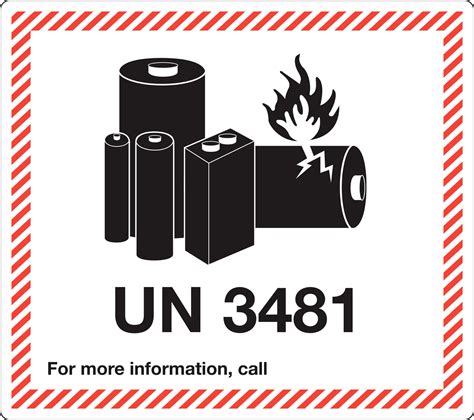Shipping products containing lithium-ion batteries (UN3481) isn't just about getting a package from point A to point B; it’s about navigating a critical intersection of safety, regulation, and logistical precision. For anyone involved in e-commerce, manufacturing, or even just sending a laptop to a friend, correctly labeling these shipments is non-negotiable. Trust me, overlooking a single detail on your UN3481 label can lead to costly fines, frustrating delays, or, far worse, a safety incident. I once saw a shipment of high-value electronics get held up for weeks because of an incorrectly sized label – a headache that could have been entirely avoided with the right knowledge upfront.
This comprehensive guide is designed to demystify the UN3481 label, providing you with the clarity and actionable steps you need to ensure every one of your shipments is compliant and secure. Whether you're new to hazmat shipping or a seasoned pro looking for a quick refresh on the latest requirements, we’ll cover everything from understanding the regulations to finding and printing the perfect label. Let's make sure your valuable cargo arrives safely and without a hitch.
Understanding UN3481: What It Is & Why It Matters
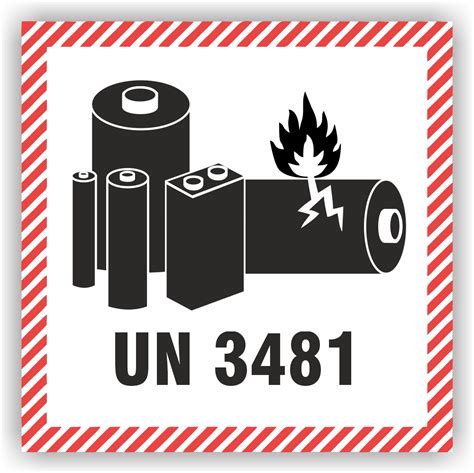
Before you even think about printing a label, it's crucial to grasp what UN3481 signifies and why it carries such weight in the world of shipping. This classification isn't just a number; it's a critical identifier that tells everyone involved in transit – from handlers to emergency responders – exactly what they're dealing with.
- UN3481 Defined: This UN number specifically refers to Lithium Ion Batteries contained in equipment or packed with equipment. This distinguishes it from standalone lithium-ion batteries (UN3480) and other battery types.
- Why It's Critical: Lithium-ion batteries, while ubiquitous, pose significant risks if mishandled, including thermal runaway, fire, and explosion. The UN3481 label communicates these potential hazards, ensuring proper handling and emergency procedures are followed.
- Regulatory Framework: Compliance isn't optional. Regulations from bodies like IATA (International Air Transport Association) for air cargo, DOT (Department of Transportation) for ground shipping in the US, and IMO (International Maritime Organization) for sea freight dictate the precise requirements for labeling, packaging, and documentation. Non-compliance can lead to severe penalties.
- Impact on Logistics: Correct labeling directly affects your ability to ship. Improperly labeled packages are routinely refused by carriers, leading to delays, increased costs, and frustrated customers.
- Beyond the Label: Understanding UN3481 also means understanding the limitations on battery size (Wh rating), state of charge, and quantity per package, which all influence the labeling and documentation requirements.
Key Elements of a Compliant UN3481 Label
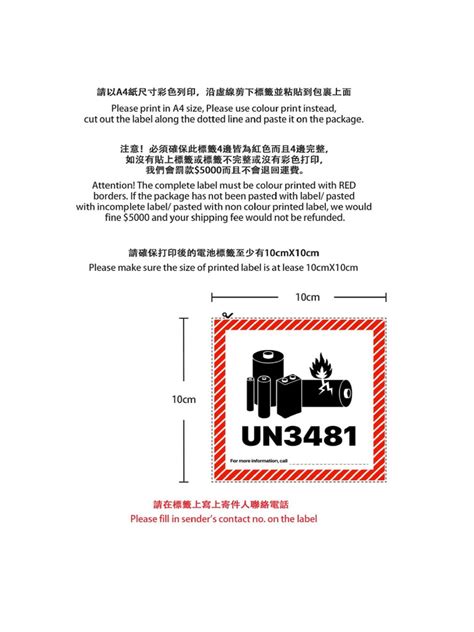
A UN3481 label isn't just a generic sticker; it's a specific format with essential information required for compliance. Missing or misrepresenting any of these elements can render your label invalid. Here’s what must be present and accurate:
- The UN Number: Clearly display "UN3481" in black text on a white or suitably contrasting background. This is the primary identifier.
- The Lithium Battery Mark: This distinctive mark features a battery symbol with an asterisk (*) to indicate the UN number, and a double hash (##) to indicate the telephone number for additional information. Below the mark, your company's name and address must be visible.
- Hazard Class 9 Label (if required): For larger quantities or certain configurations, a Class 9 (Miscellaneous Dangerous Goods) diamond-shaped hazard label may also be required. This must be at least 100mm x 100mm.
- Shipper and Consignee Information: While not part of the UN3481 mark itself, clear shipper and consignee details, including addresses and contact numbers, are crucial for the overall package.
- Dimensions and Durability: The label must meet specific size requirements (often a minimum of 120mm x 110mm for the Lithium Battery Mark, with specific text heights) and be durable enough to withstand the rigors of transit. It should be applied to a contrasting background.
- Emergency Contact Number: A readily accessible 24-hour emergency contact number that can provide specific information about the shipment in the event of an incident is often required alongside or on the label. I've personally seen carriers refuse packages at the last minute because this number was missing or incorrect – a simple oversight with massive implications.
Where to Find & Print Your UN3481 Labels
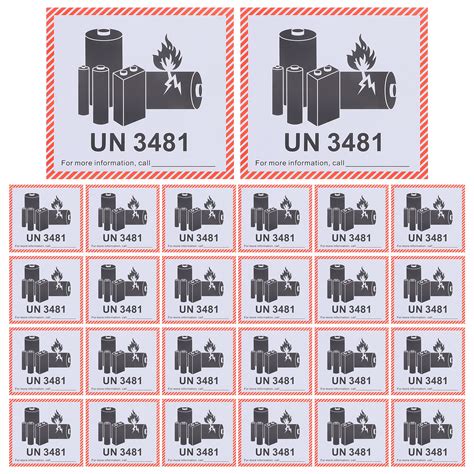
The good news is you don’t need to be a graphic designer to get compliant UN3481 labels. There are several reliable avenues for sourcing them, whether you prefer to print your own or purchase pre-made ones.
- Specialized Dangerous Goods Suppliers: This is often the most reliable option. Companies specializing in hazmat packaging and labels offer pre-printed, compliant UN3481 labels in various sizes and materials. They often also sell the necessary hazard class labels.
- Online Label Templates: For those who prefer to print in-house, many regulatory bodies (like IATA or government transport departments) or reputable hazmat consultants offer downloadable templates. Be absolutely sure these templates are up-to-date with the latest regulations.
- Shipping Software Integration: Some advanced shipping software platforms (e.g., those used by large e-commerce businesses) have integrated features that can generate and print compliant dangerous goods labels directly, often pulling data from your product catalog.
- Custom Label Printing Services: If you have high volume or unique branding needs, a professional label printing service can create custom UN3481 labels to your specifications, ensuring compliance.
- Printer Requirements for "Printable": If you're printing yourself, ensure your printer can handle label stock and that the ink is smudge-proof and durable. Laser printers are generally preferred for their resistance to moisture. Always use high-quality, adhesive label paper that won't easily peel off.
Application Best Practices: Sticking it Right

Having the right label is only half the battle; applying it correctly is just as crucial. A perfectly compliant label poorly affixed is, in essence, a non-compliant label.
- Location, Location, Location: Apply the UN3481 label to a single side of the package, ideally on a flat surface, ensuring it is fully visible and not obstructed by tape, other labels, or package features.
- Contrasting Background: The label must be applied to a background that provides a clear contrast to its colors. If your box is dark, consider using a white background label or applying a white sticker first.
- Clean Surface: Ensure the package surface is clean, dry, and free of dust or grease before applying the label to ensure maximum adhesion.
- Flat and Smooth: Avoid applying labels over creases, edges, or uneven surfaces. This can cause the label to wrinkle, tear, or peel off during transit.
- One Per Package Face (Ideally): While regulations often specify one label per package, it's best practice to place it where it's most easily seen. For larger packages, ensuring visibility from multiple angles without redundant labels can be tricky but important.
- My Personal Preference: I always recommend applying the UN3481 label *after* the shipping label, to ensure it doesn't get covered, but also on a side that's distinct from the primary shipping information. This approach works best for busy shipping departments where quick visual checks are essential.
Common Pitfalls & How to Avoid Shipping Headaches
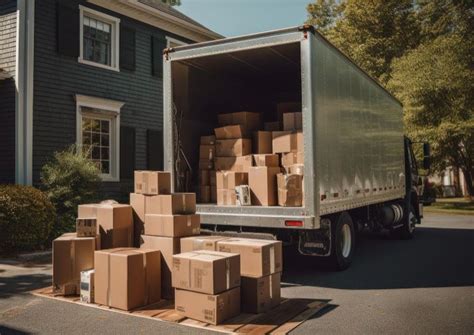
Even experienced shippers can fall prey to common mistakes when dealing with UN3481. Being aware of these pitfalls can save you significant time, money, and hassle.
- Outdated Regulations: Dangerous goods regulations are updated frequently. Using an old label template or relying on outdated information is a recipe for disaster. Always check the latest IATA DGR, DOT 49 CFR, or other relevant regulations.
- Incorrect UN Number: Confusing UN3481 (Lithium-ion batteries *in/with* equipment) with UN3480 (standalone Lithium-ion batteries) is a common, and serious, error. Each has distinct labeling and packaging requirements.
- Ignoring Battery Wh Rating: The Watt-hour (Wh) rating of the batteries determines if the shipment falls under "fully regulated" or "less-regulated" categories, significantly impacting labeling and documentation. Don't overlook this.
- Small, Illegible Labels: Trying to squeeze information onto a tiny label, or using a low-quality printer that produces faded text, is a quick way to get your package rejected. Adhere to specified minimum dimensions and ensure clarity.
- Not Including Emergency Contact: Failing to provide a valid, 24-hour emergency contact number capable of providing specific information about the battery shipment is a major non-compliance issue.
- Improper Packaging: The label is only one part. Batteries must also be correctly packaged to prevent short circuits, movement, and damage. This often involves robust outer packaging and internal cushioning. Don’t be like me when I first started, assuming the label was enough – I quickly learned the hard way that packaging is equally critical!
- Missing Documentation: Depending on the quantity and Wh rating, a Shipper’s Declaration for Dangerous Goods may be required. The label alone is often insufficient.
Beyond the Label: Comprehensive UN3481 Shipping Tips
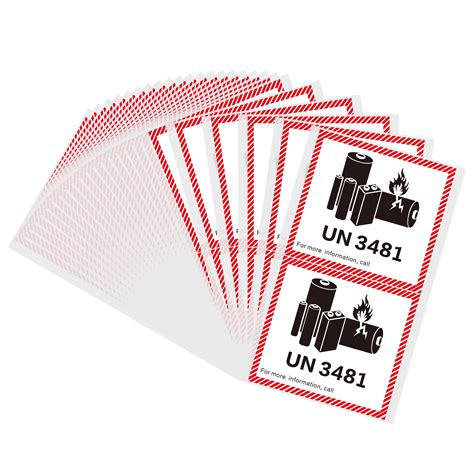
While the UN3481 label is central, it's part of a larger ecosystem of compliance and safety. Adopting a holistic approach will streamline your shipping process and bolster safety.
- Training is Key: Ensure anyone involved in packing or shipping lithium batteries undergoes proper hazmat training. This isn't just a suggestion; it's often a regulatory requirement.
- Know Your Carrier's Specifics: While international regulations set a baseline, individual carriers (FedEx, UPS, DHL, USPS, etc.) often have additional, stricter requirements or specific procedures for dangerous goods. Always check their latest dangerous goods guides.
- Proper Documentation: Maintain meticulous records of your dangerous goods shipments, including the Shipper's Declaration, Material Safety Data Sheets (MSDS/SDS) for the batteries, and any internal checklists.
- Consider Insurance: Given the value of electronics and the potential risks, ensuring adequate shipping insurance for your UN3481 shipments is a wise precaution.
- Stay Updated on Regulations: Set up alerts or subscribe to newsletters from regulatory bodies (IATA, PHMSA, etc.) and industry associations to stay abreast of the ever-evolving dangerous goods regulations.
- Invest in Quality Supplies: From sturdy boxes to industrial-strength tape and durable labels, investing in high-quality shipping supplies pays dividends in preventing damage and ensuring compliance. This is my favorite strategy because it saved me countless times from having to repack or reship.
Conclusion

Navigating the complexities of UN3481 label printing and application might seem daunting at first, but with the right knowledge and attention to detail, it becomes a straightforward process essential for safe and compliant shipping. Remember, every correctly applied UN3481 label isn't just a regulatory checkbox; it's a commitment to safety, efficiency, and the seamless delivery of your products. Take the time to understand the nuances, implement best practices, and stay informed, and you'll protect your shipments, your business, and everyone involved in the logistics chain. Now go forth and ship with confidence!
